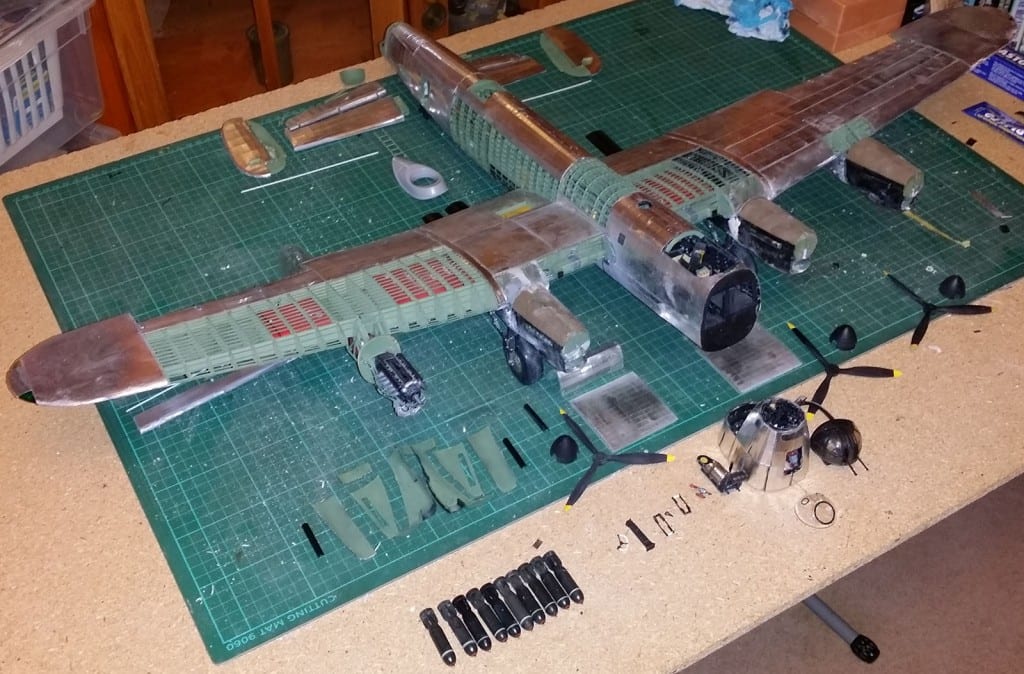Welcome back to another build diary, thank you for your patience as we move into the final stages of this build.
This is your final chance to be heard in your opinion of which aircraft we should decorate this model as. Last time we had a significant response extending our list from four potentials to nineteen. Next time we’ll present everyone with our shortlist and ask you all to choose between them. We would prefer if all of the suggestions had photographs of the aircraft, especially any nose art that we could use to guide us in our decorating. The full list of potential aircraft is below:
- An aircraft from 582 Squadron (Pathfinders) suggested by a member of Pathfinder Lodge 7255,
- L7537 of 44 (Rhodesia) Squadron letters KM-L which was shot down on a mission to Dusseldorf in August 1942,
- LL777 of 61 Squadron QR-S with its nose art of a hand holding a pair of playing cards,
- LM360 of 61 Squadron QR-O the aircraft which Bill Reid won his Victoria Cross,
- W4133 of 9 Squadron WS-Z “Zola” which we have good images for in the IBCC Digital Archive,
- ? 61 Squadron QR-X,
- JA914 57 Squadron DX-O lost over Berlin 3/4 September 1943,
- LM621 100 Squadron HW-C lost on ops to Veirzon Rail Yards 1 July 1943,
- ED497 ? Lost on Ops to Cologne,
- LL687 408 Squadron HW-C “Berlin Special” suggestion provided with photograph,
- 50 Squadron VN-B “Baker” flown in by Sir Michael Beetham and Reg Payne,
- W4157 ? WS-V “Barbara Mary” Lost 17/18 January 1943 provided with photograph,
- KB791 428 Squadron RCAF NA-A flown on by the proponent’s Grandfather,
- ? 649 Squadron OJ-A “Heavenly Hilda”
- ? 50 Squadron VN-N “Nan” an aircraft flown by James Flowers,
- ? 619 Squadron PB-X Shot down over Heilbron 4 December 1944,
- ME812 166 and 153 Squadrons AS-F/P4-F “Fair Fighter’s Revenge” flew 100+ operations including Ops Manna and Exodus,
- JB405 12 Squadron “Hellzapoppin” Flown in by D Hayhurst, for whom we have a collection in the IBCC Digital Archive
- “S-Sugar” the default which comes with the model.
Moving on to the build diary, last time we attached the wings, and covered much of the fuselage in skin.
This time we started with these parts.
Plus all of the pieces we cut a few weeks ago for the bomb-aimer’s position.
First, we assembled the smaller pieces together to create some of the bomb-aimer’s control panels, hinges for the rudders, and the bomb-sight.
These were then set aside to be primed and painted.
Next, we masked up the nose turret canopy for painting, this took a lot of masking tape, a sharp knife and quite a bit of patience. You can see it here next to some of the other components for the turret itself.
Having set aside those pieces for painting as well we moved on to marking up the pieces for rivet marking. Here you can see all of the pieces of skin to cover the bomb-aimer’s position (18 separate pieces!) with the nose section.
And here are all of the pieces prepared for rivet marking, including the three panels which are designed to be detachable.
These than all had rivet markings applied, these are the last sections which need treating in this manner.
We then attached the hinges to the rudders. You may notice that one of the hinges is missing. One of the “T” plates was missing when we opened the bag, the other half of the hinge was applied in the correct place on the main model.
Before we finally moved on to painting everything.
The nose turret and bomb-aimer’s blister went together pretty quickly after that, as did the installation of the newly finished control panels and the bomb-sight.
Here’s a slightly closer view of the nose turret fully completed.
The Bomb-sight and control panels, and the cupola.
And the bomb aimer’s bench.
Before we moved on to attaching all of the fuselage panels.
And here is a view back through the bomb-aimer’s position from where the cockpit will be.
Finally, the blister’s support ring was added along with the two “A-frames” which go inside the blister.
Next, the skin and rudders where attached to the vertical stabilisers. Then these parts were set aside to be painted with the rest of the aircraft.
Whilst all of this was going on I had passed the task of getting the engine, undercarriage bay and nacelle cowlings to actually fit together to a modeller with far more experience than I.
After a few attempts he determined that the sections of the under carriage cowlings that were meant to follow the engine bulkhead would never be able to maintain the proper shape, so he removed them and replaced them with a strip of scrap metal from the process of cutting fuselage panels.
Before using filler to close gaps around the edges.
He later removed much of the filler, but has not yet reached as far as the dorsal side of the model.
That brings us to the end of this build diary.
Next time we will be building the two bomb-bay doors (with their 72 skin panels), finishing the fuselage and building the other two turrets.

























Comments are closed.